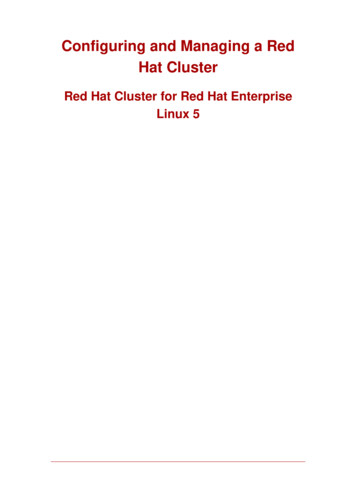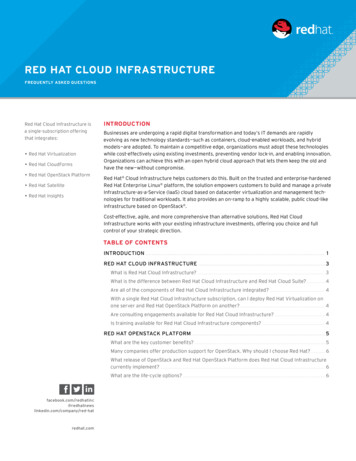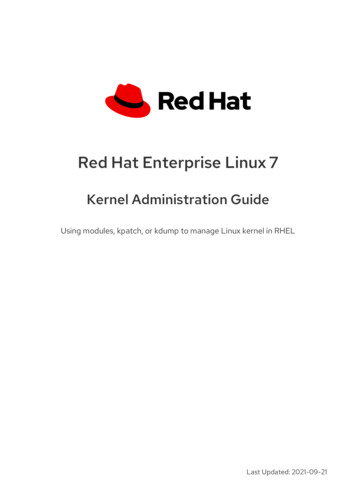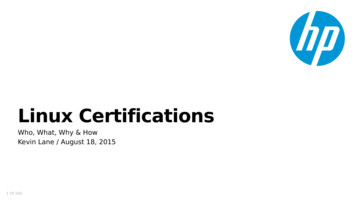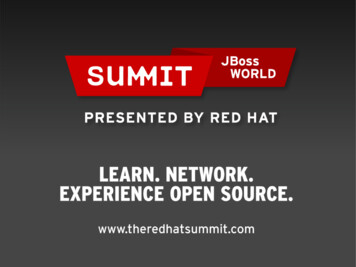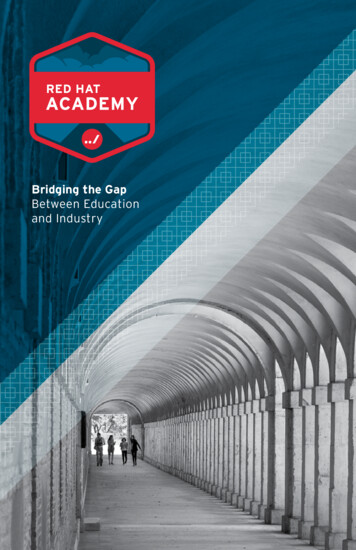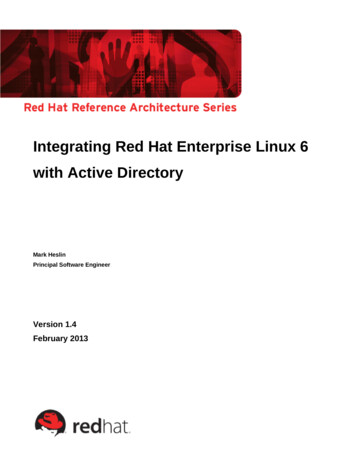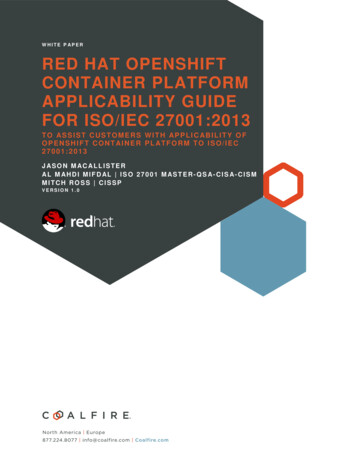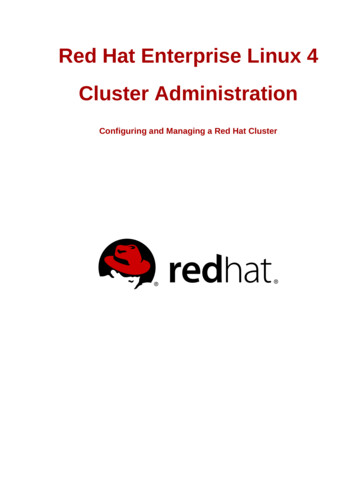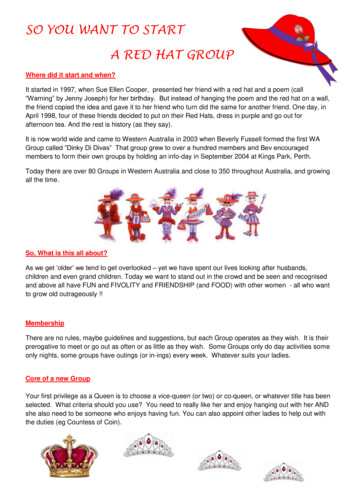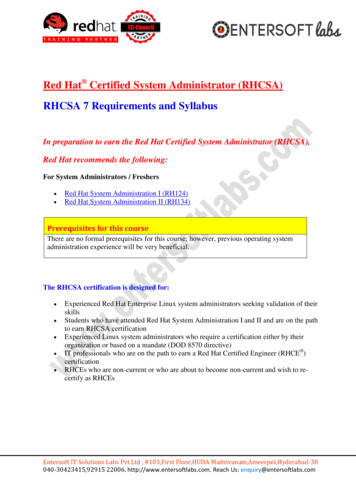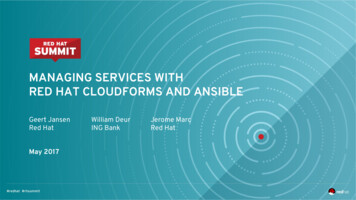
Transcription
MANAGING SERVICES WITHRED HAT CLOUDFORMS AND ANSIBLEGeert JansenRed HatMay 2017William DeurING BankJerome MarcRed Hat
AGENDA Why self service, challenges and solutions A customer perspective Demonstration
WHY SELF-SERVICE?CHALLENGES AND SOLUTIONS
DIGITAL TRANSFORMATION DRIVINGDRAMATIC CHANGES IN ITCEOCompetitive pressure driving digitaltransformationLINE OF BUSINESSChallenged to deliver services faster, atscale, and more efficientlyDEVELOPERSNeed to develop applications fasterwith greater productivityIT OPERATIONSMust provide infrastructure agility,on-demand that scales as needed“The business environment today is pushing companies torespond to ever increasing competition.In order to remain competitive, they have to deliver theirservices faster, at greater scale, and do so efficiently inorder to remain profitable.These demands drive application developers to create newapplications and deliver them faster.This further places stress on the IT Operations team whohas to provide a scalable, on-demand infrastructure thatcan service the Developers.”Gartner
SELF-SERVICE SIGNIFICANTLY IMPROVES AGILITYCEOCompetitive pressure driving digitaltransformationLINE OF BUSINESSChallenged to deliver services faster, atscale, and more efficientlyDEVELOPERSNeed to develop applications fasterwith greater productivityIT OPERATIONSMust provide infrastructure agility,on-demand that scales as needed“We analyzed the numbers and realized with RedHat we saved almost 10 years of time and almost 5 million in soft savings.”Jason Cornell, Cox automotive:Self-service benefits Service delivery times: weeks to minutesImproved compliance by usingstandardized offeringsMore efficient use of staff
TYPICAL SELF-SERVICE APPROACH1. Deploy resources through a portal2. There is no step 2
ISSUES WITH “FIRE AND FORGET” When are the resources cleaned up? (sprawl!) How to manage resources after the are deployed (day-2 ops)? E.g.: Restart VMs Get a console Snapshot a data volume See resource utilization Who owns what? What resources are owned by what service?
SOLUTION - FULL LIFE CYCLE MANAGEMENT[Self Service Portal][My Services Portal] manage [Service 1] order UserPortal[Service 2] manage fulfill Done“Classical” self service processEnd of life“My Services” for day-2 management
USERS WANT Newer version of the OSRoot accessA newer version of a libraryAn older version of a libraryBoth versions of a libraryRoot accessThe latest version of left-padRoot access?Root access!
CHALLENGEHow to Be compliant: security, regulatory, corporate, other Not be in the way
TWO WAYS TO COMPLIANCE change UserContinuouscheck“I.T.”Option 1: change control/ ITSM CMOption 2: “trust butverify” ContinuousAgentlessCross-technology
SINGLE-VM VS. MULTI-TIER SELF SERVICE
MULTI-TIER APPS: CHALLENGES Multiple types of resources to create: VMs, load balancers, subnets. Resources need to be created in certain order. Application software need to be installed. Application software needs to be configured for its role in the stack. Application software needs to be configured for its relationship with otherresources.Common solution: “Template”
TEMPLATE TYPE: CLOUD NATIVE
TEMPLATE TYPE: CLOUD ABSTRACTION
TEMPLATE TYPE: DESIGNER
ISSUES WITH TEMPLATES Lowest common denominator Declarative style limitations OR Cloud specificDeclarative is theoretically more “correct”; BUTVMs have too much state to be accurately captured declarativelyResults in lots of “glue” scriptingAnything but a toy example gets really really complex. E.g.: 4,000 line ClearWater TOSCA template (3,600 YAML 400 bash)9,000 line MongoDB template
AUTOMATION VS TEMPLATES What if we had a Simple, Powerful, Agentless orchestration language? That is understood and loved by the ops teams. With large number of integrations and big community Where it’s very easy to define the creation process of a multi-tier app Then, Automation could be the Template
AUTOMATION AS THE TEMPLATE All of the following using the same template Creation of resources On-system configuration Life-cycle actions 900 available modules Individual orchestration steps can be declarative Included in CloudForms 4.5
SUMMARY Self-service can significantly improve agility Challenges with classical self-service Life cycle managementHow to enforce compliance?How to define multi-tier apps?CloudForms 4.5 has Full life-cycle managementPowerful, agent-less policy engine for enforcing complianceAnsible “Automation is the Template” based service definition
A CUSTOMER PERSPECTIVE
What is ING and who am I Global financial institution with a strong European base Offering retail and commercial banking services in over 40 countries Lead Dev Engineer Dutch Infra department
Going through change Organisational VM deployment Why Cloudforms Component-api based
Self-service withcustom portal Single entry point The use of Cloudforms Dynamic dialogs
What we have build Single-VM provisioning workflow providing RHEL 7 IPAM IaaS API for placement Pre-register vm for backup and UAM HierAPI Ansible Monitoring / CMDB
Future Second day operations Multi-VM
DEMONSTRATIONS
CLOUDFORMS SELF-SERVICE PORTALSIMPLE SERVICE PROVISIONINGTEMPLATE SERVICE PROVISIONINGAUTOMATION PROVISIONINGFULLVISIBILITYDAY 2OPERATIONSRESOURCESECURITYGOVERNANCE CONSUMPTION
ANSIBLE SERVICES in CLOUDFORMS 4.5 Deploy new InstancesDeploy NGINX & web applicationRegister instances with ELBELBFULLVISIBILITYDAY 2OPERATIONSRESOURCESECURITYGOVERNANCE CONSUMPTION
WRAP-UP & Q&A
REFERENCES Download Red Hat at-cloudforms Red Hat CloudForms Bloghttp://cloudformsblog.redhat.com/ Red Hat CloudForms YouTube channelhttps://www.youtube.com/user/cloudformsnow
THANK YOUplus.google.com/ tVideos
OR Cloud specific Declarative style limitations Declarative is theoretically more "correct"; BUT VMs have too much state to be accurately captured declaratively Results in lots of "glue" scripting Anything but a toy example gets really really complex. E.g.: 4,000 line ClearWater TOSCA template (3,600 YAML 400 bash)
